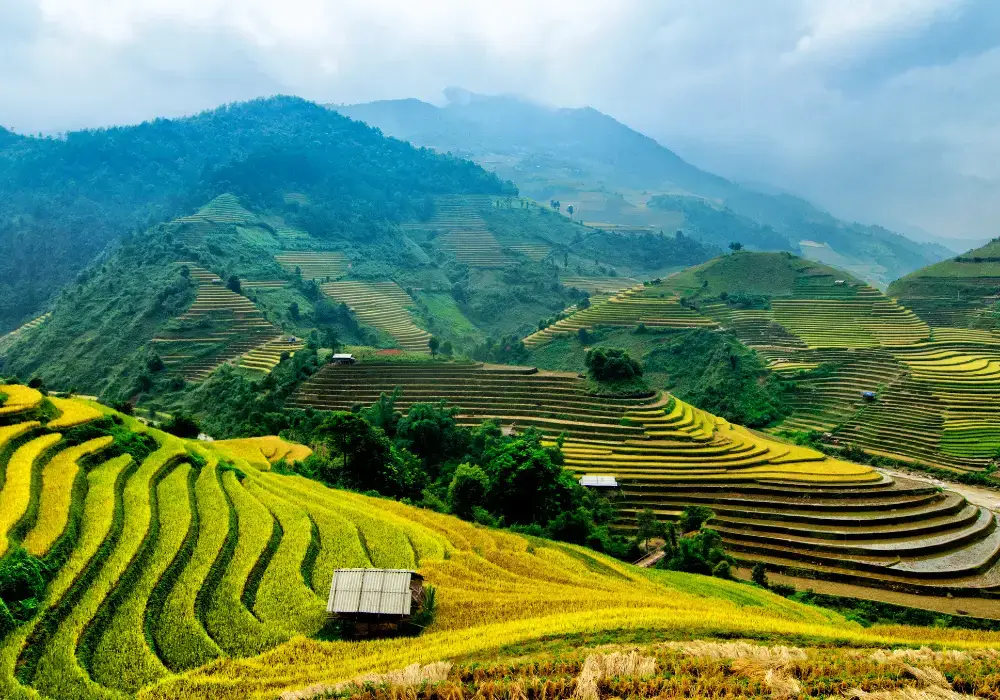Vietnam is a fantastic year-round destination, but the best time to visit depends on where you’re going and what activities you have planned. Vietnam has three distinct climate zones—North, Central, and South—each with different weather patterns.
To avoid extreme heat, heavy rains, or tourist crowds, it’s important to choose the right season for your trip. This guide will help you decide the best time for sightseeing, trekking, beach vacations, and cultural tours.
Best Time to Visit Vietnam Overall
If you’re visiting all three regions of Vietnam, the best time is March–April and September–November. These months offer:
- Mild temperatures
- Minimal rainfall
- Comfortable sightseeing conditions
If you’re only visiting a specific region, here’s what you need to know:
| Region | Best Months | Months to Avoid |
|---|---|---|
| North (Hanoi, Halong Bay, Sapa) | October–April (cool, dry, clear skies) | May–September (hot, humid, heavy rain) |
| Central (Hue, Da Nang, Hoi An, Nha Trang) | February–August (sunny beaches, dry weather) | October–November (typhoons, floods) |
| South (Ho Chi Minh, Mekong Delta, Phu Quoc) | December–April (dry, sunny) | June–September (heavy humidity, afternoon rain) |
Best Time to Visit Northern Vietnam (Hanoi, Halong Bay, Sapa)
Northern Vietnam experiences four seasons, but the best time to visit is the dry season from October to April. Expect cool temperatures, clear skies, and low humidity, making it perfect for exploring cities, trekking, and Halong Bay cruises.
- Hanoi & Halong Bay: October–April is ideal for sightseeing. Winter (Dec–Feb) is dry but chilly (as low as 10°C), making city walks comfortable but requiring warm clothes.
- Sapa & Ha Giang: For trekking, visit in March–May (lush green landscapes) or September–November (harvest season with golden rice fields).
When to Avoid Northern Vietnam
From May to September, Hanoi becomes hot and humid (above 35°C), and heavy rains hit Halong Bay and the mountains. Halong Bay cruises often get canceled due to storms, and trekking routes in Sapa become muddy and dangerous.

Best Time to Visit Central Vietnam (Hue, Da Nang, Hoi An, Nha Trang)
Central Vietnam’s dry season runs from February to August, bringing warm weather and clear skies.
- Hue & Hoi An: March–May is ideal for exploring ancient towns and cultural landmarks. June–August is hotter but still dry, making early morning sightseeing the best option.
- Da Nang & Nha Trang (Beach Cities): April–August is perfect for beach vacations, with calm blue waters and sunny days.
- Phong Nha Caves: Visit March–August for safe cave tours, as flooding can close caves in the wet season.
When to Avoid Central Vietnam
From September to November, typhoons and heavy rain hit the coast. Flooding is common in Hoi An and Hue, and many tours get canceled. October is the worst month for this.
Best Time to Visit Southern Vietnam (Ho Chi Minh City, Mekong Delta, Phu Quoc)
Southern Vietnam has a tropical climate, with warm temperatures year-round. The best time to visit is the dry season from December to April, when humidity is lower and rain is rare.
- Ho Chi Minh City & Mekong Delta: December–March is perfect for sightseeing. The Mekong Delta is lush and floating markets are active.
- Phu Quoc & Con Dao Islands: For beach lovers, November–April is ideal, with calm seas and clear skies.
When to Avoid Southern Vietnam
From May to November, expect high humidity and daily afternoon rain showers. While June–September is the rainiest period, the showers usually last only an hour and won’t ruin a trip. The Mekong Delta, however, can experience flooding in September and October.
Best Time for Popular Activities in Vietnam
Best Time for Trekking in Vietnam
- Sapa & Ha Giang: March–May or September–November (avoid rainy summer months).
- Central Highlands: December–April (cool, dry weather for hiking).
Best Time for Beach Vacations in Vietnam
- Da Nang, Hoi An, and Nha Trang: March–August (sunny and dry).
- Phu Quoc & Con Dao Islands: November–April (best swimming and snorkeling conditions).
Best Time for Cultural and City Tours
- Hanoi, Hue, Ho Chi Minh City: October–April (pleasant weather for walking).
- Hoi An Lantern Festival: Held every full moon, but best enjoyed February–April when it’s dry.
Festivals and Events Worth Experiencing
If you want to experience Vietnamese culture, plan your trip around these festivals:
- Tet (Lunar New Year, late January–February): Fireworks, street decorations, and celebrations nationwide. Tip: Book accommodations early, as domestic travel is busy.
- Hue Festival (April, every two years): A grand cultural event with performances and parades in the historic city.
- Hoi An Lantern Festival (every full moon): A magical night where the town is lit by thousands of lanterns.
- Mid-Autumn Festival (September–October): Celebrated with lion dances, mooncakes, and lantern displays.
Bottom Line: When Should You Visit Vietnam?
To get the best weather across all regions, visit March–April or September–November.
For Northern Vietnam, the best time is October to April. If you’re heading to Central Vietnam’s beaches, go March to August. And for Southern Vietnam, December to April is ideal.
By choosing the right season, you’ll avoid extreme weather, enjoy Vietnam at its best, and make the most of your trip.
Ready to Experience Vietnam at the Perfect Time?
Let us handle the details! We specialize in customized travel planning to match your ideal season, destinations, and activities. Whether you’re looking for cultural tours, beach escapes, or trekking adventures, we’ll craft the perfect itinerary for you.
Contact us today and start planning your unforgettable Vietnam trip!




